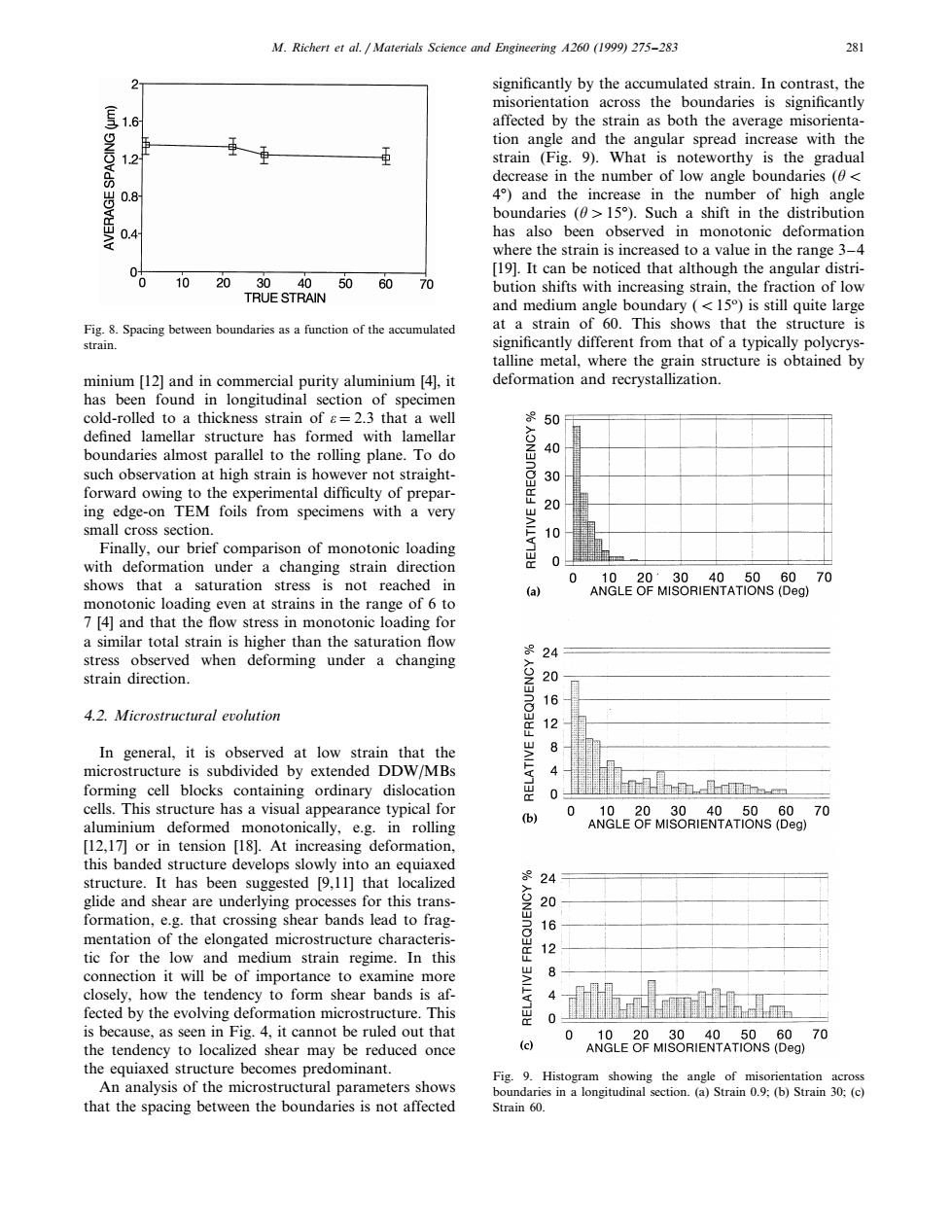正在加载图片...

M.Richert et al.Materials Science and Engineering A260 (1999)275-283 281 2 significantly by the accumulated strain.In contrast,the misorientation across the boundaries is significantly 1.6 affected by the strain as both the average misorienta- tion angle and the angular spread increase with the 12 strain (Fig.9).What is noteworthy is the gradual decrease in the number of low angle boundaries (0< 0.8 4)and the increase in the number of high angle boundaries (0>15).Such a shift in the distribution 安 0.4 has also been observed in monotonic deformation where the strain is increased to a value in the range 3-4 [19].It can be noticed that although the angular distri- 10 20304050 60 70 bution shifts with increasing strain,the fraction of low TRUE STRAIN and medium angle boundary (<15)is still quite large Fig.8.Spacing between boundaries as a function of the accumulated at a strain of 60.This shows that the structure is strain. significantly different from that of a typically polycrys- talline metal,where the grain structure is obtained by minium [12]and in commercial purity aluminium [4],it deformation and recrystallization. has been found in longitudinal section of specimen cold-rolled to a thickness strain of s=2.3 that a well 50 defined lamellar structure has formed with lamellar boundaries almost parallel to the rolling plane.To do 40 such observation at high strain is however not straight- 30 forward owing to the experimental difficulty of prepar- ing edge-on TEM foils from specimens with a very 20 small cross section. 10 Finally.our brief comparison of monotonic loading with deformation under a changing strain direction 0 shows that a saturation stress is not reached in 0 10 20·30 40506070 6 ANGLE OF MISORIENTATIONS(Deg) monotonic loading even at strains in the range of 6 to 7 [4]and that the flow stress in monotonic loading for a similar total strain is higher than the saturation flow stress observed when deforming under a changing 24 strain direction. 20 16 4.2.Microstructural evolution 12 In general,it is observed at low strain that the 8 microstructure is subdivided by extended DDW/MBs forming cell blocks containing ordinary dislocation 0 hH且里o- cells.This structure has a visual appearance typical for (b) 0 10203040506070 aluminium deformed monotonically,e.g.in rolling ANGLE OF MISORIENTATIONS(Deg) [12,17]or in tension [18].At increasing deformation, this banded structure develops slowly into an equiaxed structure.It has been suggested [9,11]that localized g glide and shear are underlying processes for this trans- 20 formation,e.g.that crossing shear bands lead to frag- 16 mentation of the elongated microstructure characteris- 12 tic for the low and medium strain regime.In this connection it will be of importance to examine more closely,how the tendency to form shear bands is af- fected by the evolving deformation microstructure.This 738 0 is because,as seen in Fig.4,it cannot be ruled out that 0 10 2030 40 506070 the tendency to localized shear may be reduced once (c) ANGLE OF MISORIENTATIONS(Deg) the equiaxed structure becomes predominant. Fig.9.Histogram showing the angle of misorientation across An analysis of the microstructural parameters shows boundaries in a longitudinal section.(a)Strain 0.9:(b)Strain 30:(c) that the spacing between the boundaries is not affected Strain 60.M. Richert et al. / Materials Science and Engineering A260 (1999) 275–283 281 Fig. 8. Spacing between boundaries as a function of the accumulated strain. significantly by the accumulated strain. In contrast, the misorientation across the boundaries is significantly affected by the strain as both the average misorientation angle and the angular spread increase with the strain (Fig. 9). What is noteworthy is the gradual decrease in the number of low angle boundaries (uB 4°) and the increase in the number of high angle boundaries (u\15°). Such a shift in the distribution has also been observed in monotonic deformation where the strain is increased to a value in the range 3–4 [19]. It can be noticed that although the angular distribution shifts with increasing strain, the fraction of low and medium angle boundary (B15o ) is still quite large at a strain of 60. This shows that the structure is significantly different from that of a typically polycrystalline metal, where the grain structure is obtained by minium [12] and in commercial purity aluminium [4], it deformation and recrystallization. has been found in longitudinal section of specimen cold-rolled to a thickness strain of o=2.3 that a well defined lamellar structure has formed with lamellar boundaries almost parallel to the rolling plane. To do such observation at high strain is however not straightforward owing to the experimental difficulty of preparing edge-on TEM foils from specimens with a very small cross section. Finally, our brief comparison of monotonic loading with deformation under a changing strain direction shows that a saturation stress is not reached in monotonic loading even at strains in the range of 6 to 7 [4] and that the flow stress in monotonic loading for a similar total strain is higher than the saturation flow stress observed when deforming under a changing strain direction. 4.2. Microstructural e6olution In general, it is observed at low strain that the microstructure is subdivided by extended DDW/MBs forming cell blocks containing ordinary dislocation cells. This structure has a visual appearance typical for aluminium deformed monotonically, e.g. in rolling [12,17] or in tension [18]. At increasing deformation, this banded structure develops slowly into an equiaxed structure. It has been suggested [9,11] that localized glide and shear are underlying processes for this transformation, e.g. that crossing shear bands lead to fragmentation of the elongated microstructure characteristic for the low and medium strain regime. In this connection it will be of importance to examine more closely, how the tendency to form shear bands is affected by the evolving deformation microstructure. This is because, as seen in Fig. 4, it cannot be ruled out that the tendency to localized shear may be reduced once the equiaxed structure becomes predominant. An analysis of the microstructural parameters shows that the spacing between the boundaries is not affected Fig. 9. Histogram showing the angle of misorientation across boundaries in a longitudinal section. (a) Strain 0.9; (b) Strain 30; (c) Strain 60